When Should I Start Seeds? Indoor and Outdoor Charts
This post may contain affiliate links. Read my full disclosure here.
I have quite a few new gardeners ask me, “When should I start seeds?” It really depends on where you are and what you are planning to grow.
Most seed companies label the packets with basic growing information, but seed starting charts can help keep your gardening a little more organized.
A planting schedule can help you to spread your planting out so you don’t feel rushed. When you try to cram too much to do in too little time, it doesn’t get done properly. Vegetable gardening should help relieve stress, not cause it.
In this article, I’ll share when to start seeds indoors and outdoors, with charts for fall and spring. We also cover tips for happier transplants and grouping your seedlings into crop families.
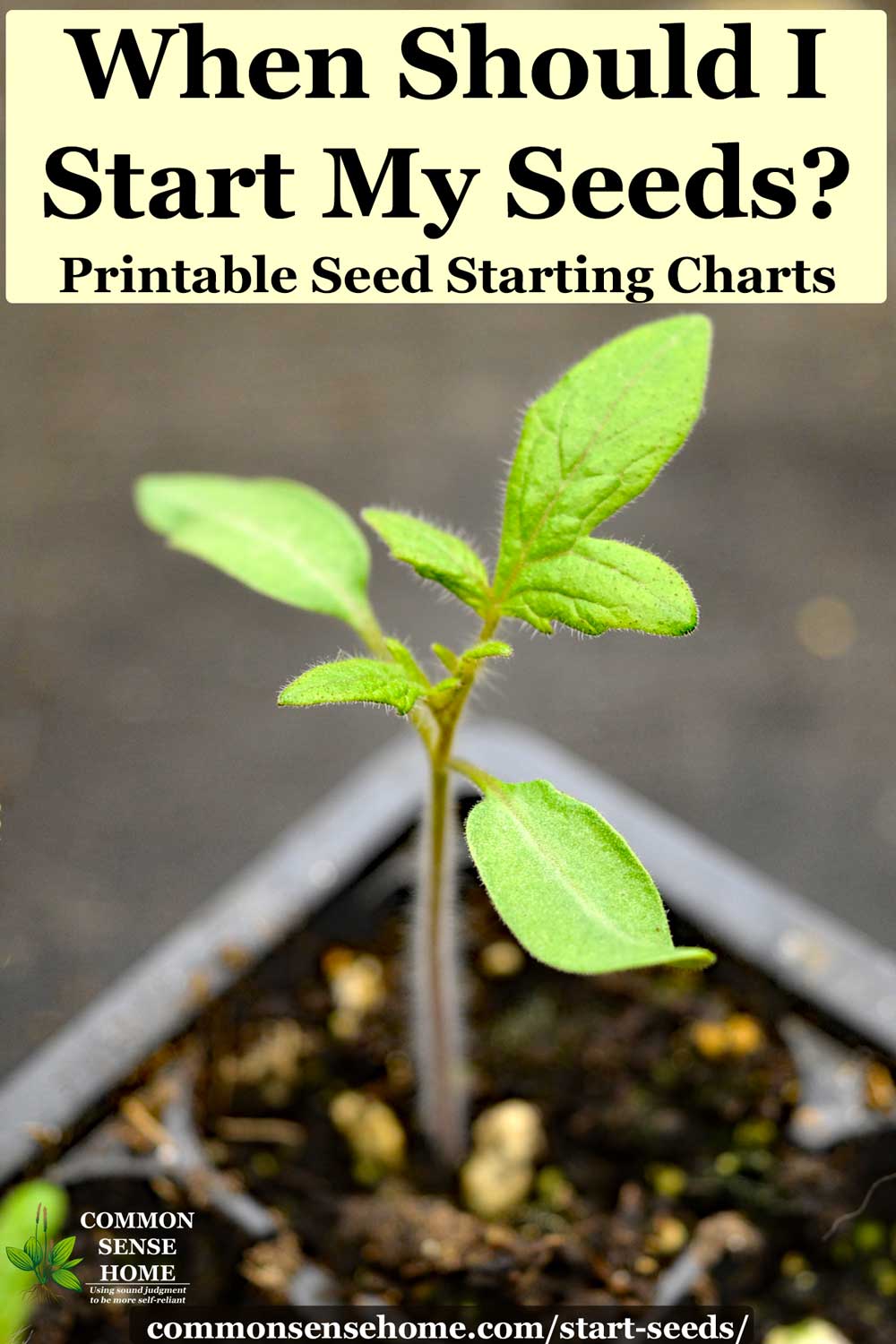
Seed Starting Tips
If you need tips on how to start seeds, please see, “Starting Seeds Indoors – Step by Step Guide with Troubleshooting Tips“.
We cover how to choose the right seed starting mix or potting mix, when to use a heat mat, proper air circulation, drainage and grow lights.
Remember, a rule of thumb is that seeds get planted roughly 3 times as deep as the diameter of the seed. Don’t bury tiny seeds, or they’ll have a tough time reaching the surface.
Using Plant Families to Plan When to Start Seeds
If you’re anything like me, you have dozens of little seed packets waiting for you to give them some love and some quality dirt time. I like to sort my seeds into crop families, because when you grow plants that are similar, they have similar care needs.
The Crop Families I use are:
- Herbs – Start Indoors and Direct Sow
- Flowers – Start Indoors and Direct Sow
- Tomatoes – Paste, slicing and small-fruited
- Other Nightshades – Peppers, Eggplant, Tomatillos, Ground Cherries, Cape Gooseberries, Huckleberries
- Leafy greens – Spinach, strawberry spinach, mache, lettuces
- Brassicas – cabbage, broccoli, kale, Brussels sprouts, cauliflower
- Cucumbers – pickling, slicing, and Armenian
- Melons – Muskmelon, Watermelon, Honeydew and other heirloom melons
- Root vegetables – Carrots, turnips, beets, parsnips, rutabagas, kohlrabi, radishes
- Onions
- Beans – Snap and Shell
- Peas – Snap, Shell and Snow
- Corn
- Squash and Pumpkins
- Potatoes
I mix flowers and herbs in with my fruit and veggies as companion plants. For more information, see “Companion Planting for the Garden (The Easy Way)“.

Stratification (Cold Time Before Planting)
Some herb and flower seeds require stratification (time in the freezer) for germination. Check your seed packages or garden catalog for this information when trying new varieties.
Also, if you want really early flower blooms, you have to do like the nurseries and start your plants very early. In some cases the decorative spikes for flower basket are started nearly a year in advance.
I don’t like the extra hassle of starting seeds super early, so I don’t sow seeds until around mid March – except for onions, which I sometimes start in February.
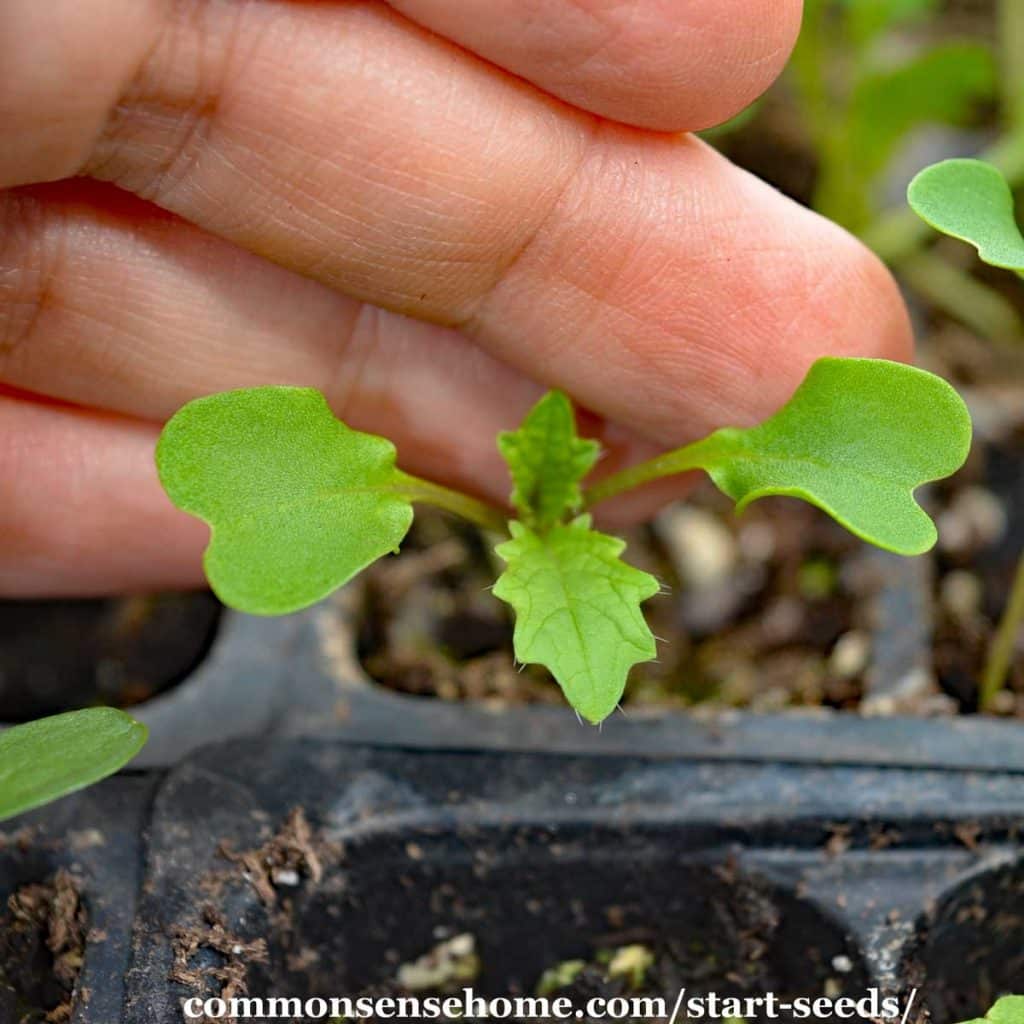
How to Use the Seed Starting Charts
To use the seed starting charts, you need to determine the average last date of spring frost and the average first date of fall frost in your area.
You can do this based on experience, by contacting your local cooperative extension office, or by checking online at a site like Dave’s Garden Frost Date by Zip Code calculator.
Please note that these dates are somewhat like a serving suggestion – what you see may not always be what you get. Mother Nature has her own ideas about each given year.
I’ve been caught on several occasions scrambling to cover transplants when an extra late frost hits. See “Protecting Plants from Frost – 12 Ways to Beat the Cold Weather” for tips to deal with wonky weather.
When to Start Seeds Indoors and Transplant Seedlings Outside
You need to know your local growing season. Once you find your average frost free date, plug that date into the chart and use it to calculate when to plant vegetables.
If you plant the seeds too early you will likely lose your crop. Planting your seed to late and you may not get ripe vegetables. Timing is everything.
For example, my average date of last frost is May 26. I start seeds over the spring months based on that date.

Adjust your planting schedule based on your average frost free date. For instance, if your last frost free date is May 15, you should seed early cabbage indoors in Late March, harden in Late April, and transplant in Early May.
What Does “Harden” Your Plants Mean?
In the chart, you’ll see the word “harden”. When you start plants inside, they need a gentle adjustment period before moving out to the garden full time. This is referred to as “hardening off”.
You make your plants tougher (harden them) so they are able to withstand the wind and sun of being planted outdoors.
Would you like to save this?
To harden off seedlings, I place them outside in a protected location on a nice day. Indirect sunlight out of strong winds is best to start. Make sure they are not in strong direct sunlight. Too much sun bakes little seedlings very quickly.
One the first day they go out for a few hours, then longer as they have a chance to get used to the change. Be mindful that small seedling containers may dry out much faster outside than indoors.
I usually move mine out to my cold frame, and then lift the lid to expose them to moving air. Once they are used to that exposure, I move one batch out of the cold frame and the next batch in.
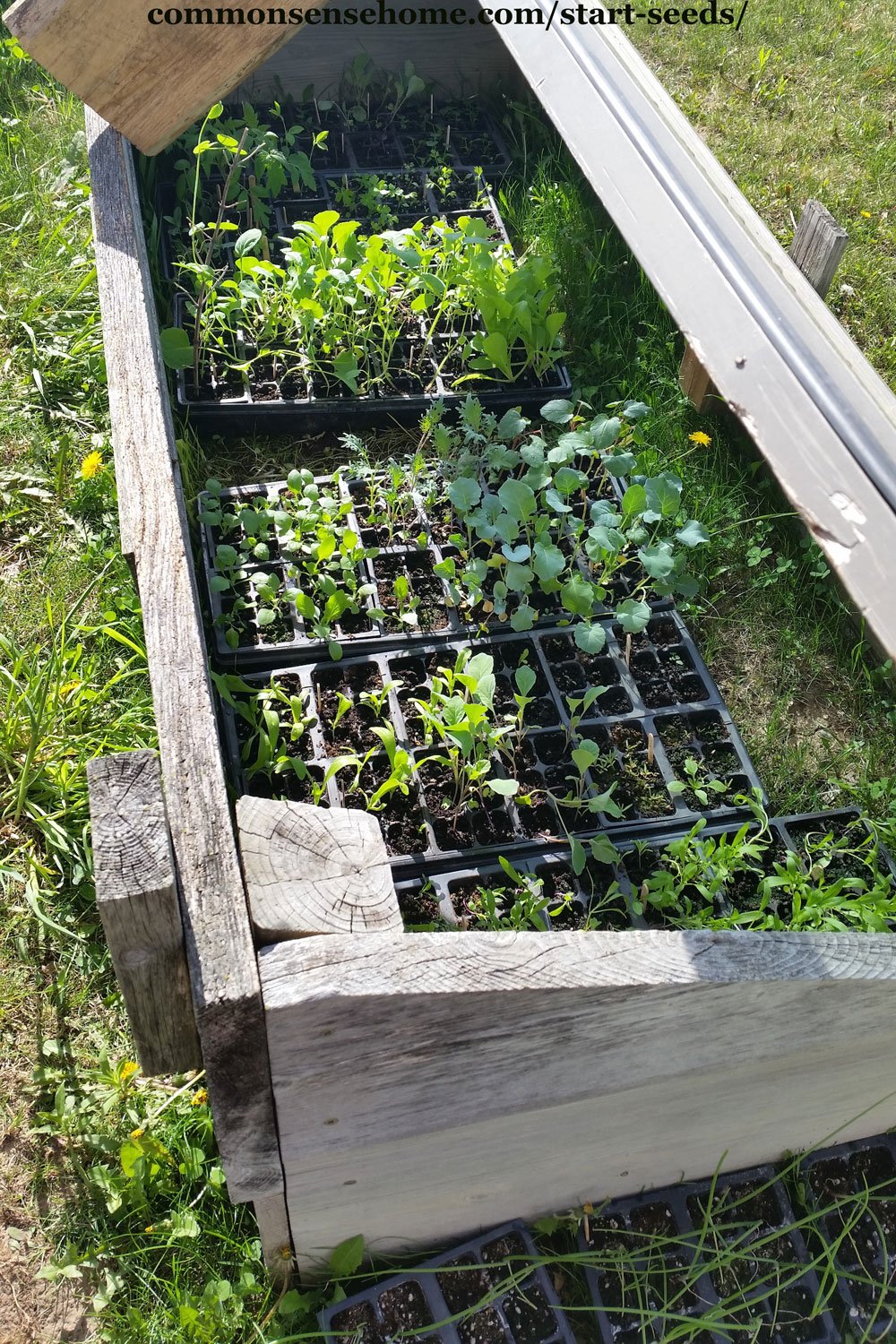
We have a lot of wind, so I still tend to keep seedlings near our home or cold frame until transplanting out in the garden.
When transplanting into the garden, it’s best to pick a slightly overcast with little wind, if possible. I plant later in the afternoon, so the small plants aren’t exposed to the midday sun on their first day out.
For a more detailed explanation and photos of how I plant out my tomato transplants, visit “How to Grow Tomatoes Organically – 7 Steps for Success“.
Spring Schedule of Outdoor Seed Sowing
Start these seeds directly in the garden in spring, or start indoors and transplant at the times listed below.
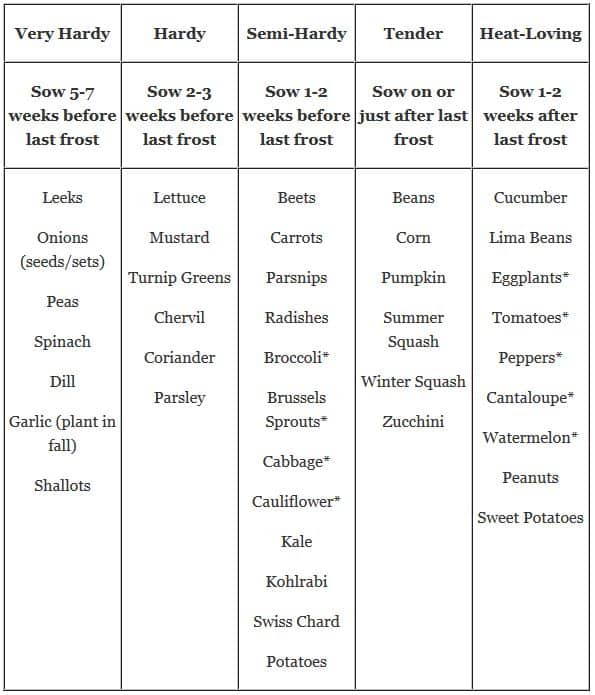
* Best as transplants
Summer Schedule of Outdoor Seed Sowing
You can start seeds directly in the garden for the plants listed below to get an extra late season harvest. Keep in mind that you’ll need to keep the soil moist and not too hot for germination. (Light mulch such as grass clippings can help.)
Consider planting your low growing fall crops inside a small cold frame, so that you can cover them to extend growing and harvest.
See ” Protecting Plants from Frost – 12 Ways to Beat the Cold Weather” for more ideas.
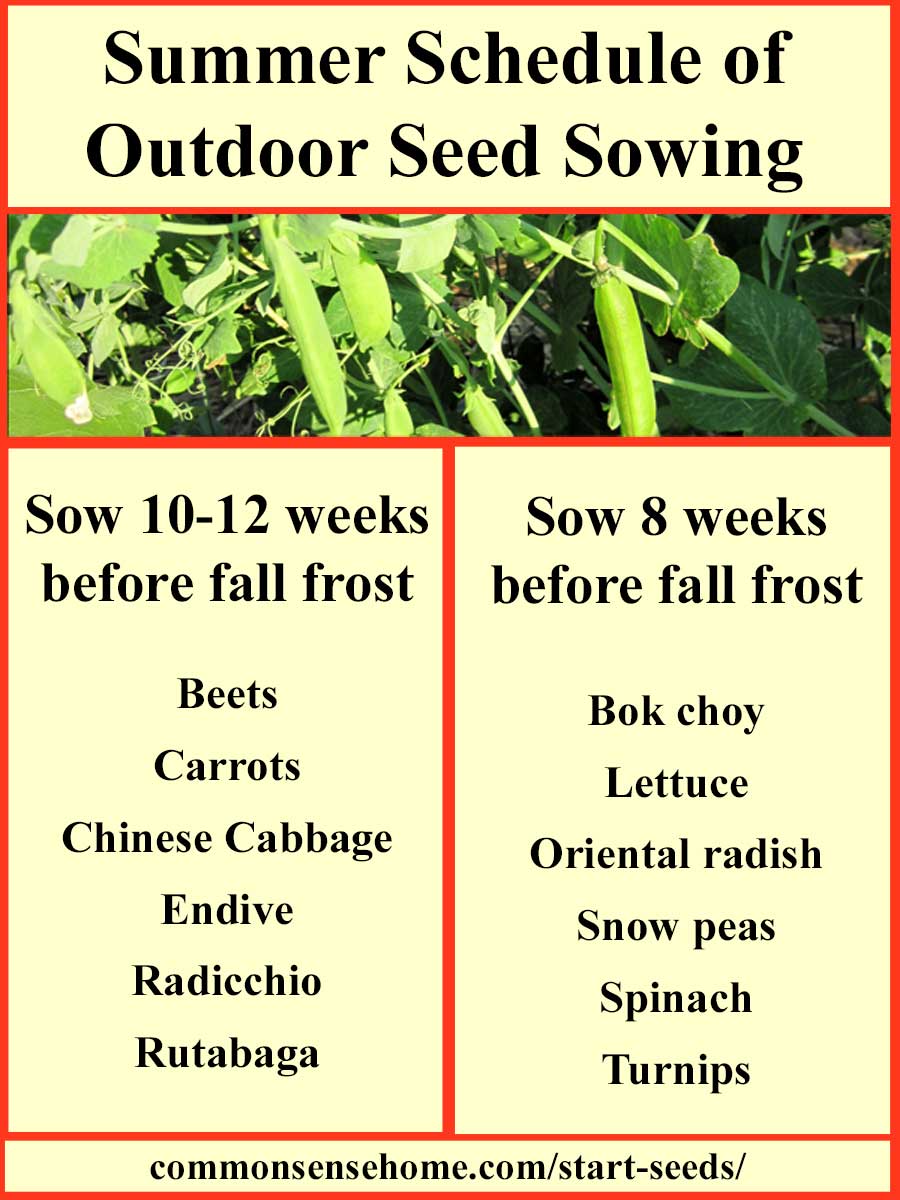
To get the printable version of the charts, you can use the link below. The pdf displays the calendars more nicely than they display on screen.
Adjust the dates for your area and keep them in your garden planner.
Get the Printable Seed Starting Calendar PDF here (dates left open)
More Gardening Tips and Information
You may also enjoy our Gardening page, which lists all of our gardening articles, including:
Build Your Own Simple Seed Starting Shelves
10 Heirloom Seed Companies You Don’t Want to Miss
Grow Tomatoes from Seed – Save Money, Get More Varieties
How to Store Seeds (for Next Year or Long Term)
How Long do Seeds Last? (with Printable Seed Viability Charts for Veggies, Herbs, and Flowers)
Some handy seed starting supplies.
Some of my favorite garden helpers.
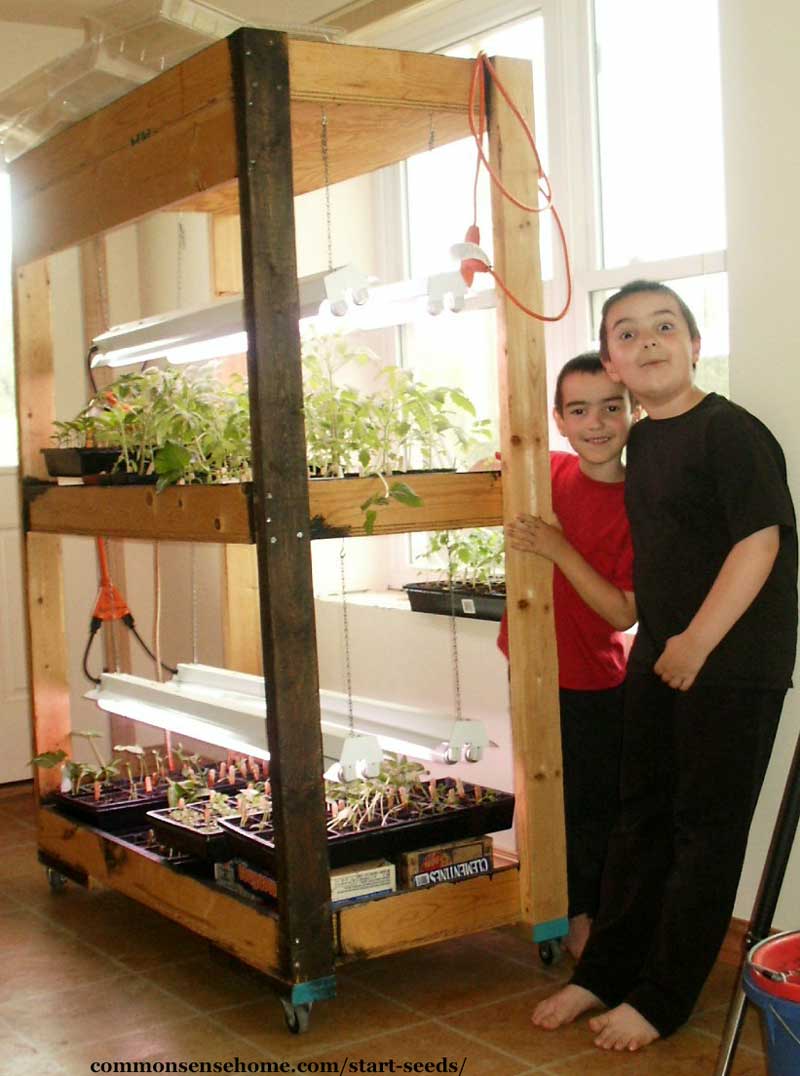
I was hunting through old photos for this post, and this was too cute not to share. Now they’ve grown into strapping young men. 🙂
Originally published in 2014, last updated in 2020

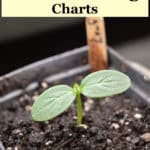


Hi Laurie, another good calculator to use is https://soilcalculator.com/gardening/frost-calculator
One benefit it adds over Dave’s is that it can show you the elevation of the weather station where the data came from. It also allows you to choose different weather stations to see their data. This helps in more mountainous areas.
Another great, fundamental article, Laurie! I am curious about your cold frame design. Do you still use it, or does the greenhouse make it unnecessary? We get strong crosswinds in the zone where a greenhouse would be most practical, and a high groundwater table, which I think might make a concrete foundation subject to extreme frost heave. W have tried making a couple of cold frames and feel like we are missing pertinent information to to build one suited to our Zone 3 climate and northern latitude. thaks!
Hi Sandy.
We still have our cold frames, though we’ve defaulted in recent years to using the greenhouses more often than not. Given their size, the cold frames are a little more awkward to work with than the greenhouses. Our frames are getting older, too, and need to be rebuilt or replaced soon, as some of the boards are in rough shape.
For a colder climates, I’ve seen people form boxes out of straw bales for insulation, with a window on top. Of course, the height of the bales reduces light penetration to the plants compared to a low front/high back setup. You could also try adding insulation to the walls.
I probably just missed it, but what zone are you in? I’m in zone 5, coastal southern Maine. Thanks, Laurie! Great and very helpful article.
We’re on the boarder between zones 4 and 5, about 15 miles west of Lake Michigan. In theory, we’re 5 on many maps, but we have high winds and some frost pocket issues, so I plan more towards zone 4.
You should be able to find your local last frost and first frost dates by searching “frost date (city near your location)”.
Can you post any suggestions (or write an article) using a greenhouse? We purchased a small one from Costco, and it is too hot and too cold. Or it is just right and we have no clue how to use a greenhouse in the spring. As the temp inside (on a sunny cold day) gets into the 90’s even with the (single) window open and the vents at the bottom open. Then at night when it goes down to freezing, it goes to freezing, even with the windows and vents closes. We have bricks as floor, black 5 gallon buckets of water all around inside to keep in heat, but it does not work. HELP!
Unfortunately, I don’t have a quick fix for that. The small plastic greenhouses have so little thermal mass and thin walls that even with the steps you’ve taken (which would be what I would recommend to start), the temps are difficult to moderate. They are affordable and easy to install, and they sell a ton of them, but they don’t work very well.
As a workaround, if it’s possible to move the greenhouse, putting it snug against a building or heavy wall on the south may help moderate the cold swings. You use the thermal mass off the building or wall to buffer the greenhouse. To buffer high temps, throwing a shade cloth over the top to block the sun can help.
Bigger greenhouses have more thermal mass, so they hold heat better, and normally have thicken walls or even double walls to deal with freezing temps, and heaters. Even my polycarbonate greenhouse that is protected on the north by a shed will only keep frost tender plants from damage a few degrees below freezing, and that’s 10×20 with insulated walls and water jugs for extra mass. Right now I only have cold tolerant plants out there, as we are expecting snow this weekend. If it gets too cold, I’ll bring them inside.
I’ve found that an old fashioned cold frame is a more robust alternative. We have two built with wooden box frames and old patio doors. I prop up the doors to vent, and the double pane glass provides insulation even though the seals on the doors were broken. Since the boxes are close to the ground, the ground also helps moderate the temperature swings. If there’s a company that replaces doors and windows in your area, you can put in a request with them for salvaged materials. They might be glad to have someone take some instead of hauling it to a landfill.
Hi Laurie, Thanks for adding the part about hardening off. This is perhaps the trickiest part of starting indoors, because you can’t mess up and leave them out too long. It’s like cooking…you have to set a timer sometimes. A coldframe or greenhouse is ideal, for sure. Thanks for a thorough article.
HI. I would like to start my seeds inside. They are called Calceolaria uniflora seeds.
I’ve never worked with those, but this site has instructions for related species – http://www.thegardenhelper.com/calceolaria.html
This is great! I have started my own plants from seed before, but only a few. I really want to plant a little bigger garden this year. And would love to start most of my plants from seed. Thank you for sharing this!
You’re welcome, Bethany.
Hi Laurie! All of the information here is exactly what I’ve been looking for. I’m fairly new to starting seeds indoors, so I’m learning as I go. I have my own little setup going, but I’m really hoping to expand and build my own greenhouse within the next few years. I love reading all of your wonderful posts!
Hi Angie. Thanks for stopping by. I love all the beautiful garden photos you share.
I’ve been reading your site since last fall. I was looking forward to your spring information and got it. Yours is the first one that is written with specifics – that can be modified to use with your own locale. I too have a 4-tier plastic covered greenhouse that I put in a southeast facing window. Evidently what I have been doing to get spindly frail starts is that I’m starting them too early for the hardening off and transplanting – according to my “new” schedule. Last year my tomatoes got so tall I had to remove a shelf to give them room. Then when I planted them in my raised beds I had to lay them down. So this year I will contain my enthusiasm and wait, wait, and then wait some more before starting my seeds. Thanks so much for your help.
Laying tomato seedlings down into a shallow trench and covering them with soil is a technique for developing a stronger root system and getting more nutrition into the plant. Tomato stalks will root readily with this technique. I tried it years ago where soil was very shallow, I used raised bed planters,and it worked well. Just be mindful about not stepping on that zone.
Love that picture of your garden helpers! Thanks for all the great information you provide.
You’re welcome, Michelle, and thank you. My helpers are much bigger now, but still my planting partners.
I live in Reno, Nevada (near Lake Tahoe) and while I have a nice sized lot, I just can’t seem to grow much of anything. My fruit trees do well (if we don’t get a late frost, which happens alot) but as for growing vegetables and such, meh! However, I faithfully follow your blog and wanted to pass on a funny something I saw on Pinterest. Being LDS, we are encouraged (alot!) to have a supply of food and supplies and such for emergencies…of whatever nature. I adhere to this and my basement looks like a small 7-11. I follow Pinterest alot and was noticing that several early planting pins are showing up. One just made me chuckle…use old stale ice cream cones for starting the seedlings! Makes perfect sense to me…have you ever tried this?
If everyone would stock up as much as the LDS folks, I think many people would be much better off.
On the stale ice cream cones – nope, haven’t tried it. I’m sure it would work, but you’d have to be careful not to ever get your seedlings too wet, or the cone would fall apart. The same goes for the toilet paper tubes, and newspaper planters. I start hundreds of seedlings each year, so I appreciate the durability of my plastic trays, which I reuse for many years.
Hi Laurie,
Thank you for this post. I will repin it to spread the word.
Monica
Can I start seeds like tomatoes, cucumbers, and bell peppers in large plastic pots and just let them grow/sprout in those pots? Im not planning on transplanting to a garden or anything, I want to be able to enjoy on my patio. Thanks.
Sure, that shouldn’t be a problem as long as you have the space for them. I do prefer working with self-watering containers, either purchased or DIY, because they are less stressful to the plants. Given the space to do so, plants will normally send out roots that are larger than the above ground foliage, looking for nutrients. In a pot, there’s limited space, but at least the self-watering reservoir can act as additional nutrient storage.
I’m a 77 yr old living in zone 2- grow most of my own food; vegetables, fruit and herbs, it requires a canning and freezing schedule which includes 400 jars plus two freezers plus countless hours of happy gardening. Start all my own plants in a greenhouse built from cast-off windows and throw-away lumber, plus lighted tables made with old light fixtures. for someone just starting out, the learning curve is formidable but the rewards are worth everything. just read and read and visit other gardens and ask most old people; they’ll be happy to tell you and maybe even help you in your garden..good luck and good eating and stay away from the chemically produced food..there’s lots better!
That’s a pretty impressive system you have there, especially for zone 2. Do you use heat in your greenhouse at all?
I partition off a small section of my greenhouse under a 4ft, 4-tube fixture and heat it with a cast-off heating pad, plus I use bottom heat to start the seeds that need it. once seeds germinate and are growing I move them to a south facing window to continue growing. at this point, my greenhouse is not heated unless absolutely necessary. ive registered temps as low as plus 3cel (about 35*f) but the plants have survived fine. I have several plastic covered lids for some of my grow boxes and start setting out plants under them in april with a blanket handy if it drops below -4*c, which it often does.. I’ve harvested greens, onions and radishes as early as mid-may and as late as mid-nov from under those covers
Still experimenting with the greenhouse here, and so far if it’s above freezing, everything was fine. Below zero F is where we ran into problems without supplemental heat.
my greenhouse is a 14×20 addition on the south side of my house with a door I can leave open and also a window into my house. The floor is 3 layers of chipboard with plastic between each layer and insulated from the bottom. the walls, for the first 4 ft. are also insulated and sheeted. all of the windows are at least double paned, depending on what was available, and every thing is as airtight as I could get it. On a sunny day in the winter it’s a pleasant place but cools off rapidly at night. I don’t smoke, drink, play golf, travel, etc. so I feel ok spending a little on some extra heat when necessary..
Interesting, I haven’t heard of someone insulating the floor before. We have a small attached greenhouse, but I did have some issues with mice when I left the door open to provide heat. Naughty little buggers.
I start my seeds inside on heated trays with black plastic on top. I think the seeds germinate faster? Any thoughts on this?
As long as the seeds you are trying to start don’t need light to germinate, this should be okay, but I prefer clear plastic.
When to start seeds, around here, means anytime it’s daylight. Really. Any month of the year. I’m 10 degrees North of the Equator here in The Philippines and its sort of a different world. Right now we’re busy harvesting coffee and I think there’s a pineapple or two ready to eat. And of course we get bananas and papayas ever week. Regular veggies we get to harvest continuously as long as we also plant continuously.
Are you trying to make me jealous or convince me to move south? 😉
Yes to both I have to admit… I have a bad habit of gloating sometimes. As far as moving south, you’d have to visit and feel that out for yourself; it’s certainly not for everyone but suits me well.
Anywhere within this band of latitude (South America, Asia, etc.) would take adjustment for anyone used to living and gardening in a temperate zone; my experience was from SF Bay area to Northern Idaho. The cultural adjustments are another story altogether! The trade-offs are incredible though, on both accounts. Bromeliads are showy, salable and practically grow like weeds here (pineapples are in this family); orchids grow wild everywhere and its easy to have a trouble-free collection of interesting varieties; poinsettias grow outside anywhere up to 20 feet in white as well as a few shades of red.
As for the cultural adjustments the poverty was one of the first and most shocking things to hit me when I first arrived for a visit almost 10 years ago. It has not been hard at all to become somewhat of an advocate in my own small way for improving the lives of a few of my neighbors who mostly live on less than $3/day: over 100 families now have electricity in their homes for the first time because my wife and I have helped with the application process and we continue to work to bring reliable water supply to thousands of homes in our district. It isn’t all safe potable water, but hey, running water into your home is already a big deal!
I think I’d miss the four seasons, but there are times when that’s tempting, especially when we get below zero and the pain from my husband’s old frostbite injury starts acting up. We have a lot of good friends and neighbors here, too, so much more than our last place.
It’s hard to imagine that level of poverty, but I’m glad that you and your wife have been able to help out.
have you ever looked into the “ruth stout” method of gardening. a no till method where you just keep adding compostables to the garden. i saw a man in england using a similar method with spectacular results, i cant remember what he called it. i have been successful sol far, but only on a small scale since we are moving this summer
Yep, I’m familiar with the concept, but have run into number of complications with actual implementation in my area. First off, I have a very large garden. I do try to mulch large portions of it, but the quantity of mulch I’d need to bury it deeply in mulch is simply not available in our area unless I want to shell out some serious cash or do some major scrambling in a hunt for something like spoiled hay. Most folks around here use up their mulch suitable carbons themselves.
Second, and more importantly, if I leave the ground covered year round in mulch, it’s really, really slow to warm up in spring. Last year, I had two sections of a bed right next to each other, one mulched, one not. I decided to plant potatoes in early spring. Where there was no mulch, the ground was workable and warm. Where we pulled back the mulch to plant, it was still really cold – so cold it was uncomfortable to put your hand in it. We planted some of the potatoes, but stopped after a small portion of the mulched area was done. We pulled back the mulch and waited a week to plant the rest. Those we planted in the mulched area without pulling back the mulch rotted instead of growing.
Also, in our area, it can be very humid. Too much mulch during the rainy season can lead to a slug infestation of biblical proportions.
So I do mulch, but I mulch selectively.
I’ve had similar experience with heavy mulch. the ground was still frozen solid under 8 inches of straw well into june. if you only experience surface frost it might work ok. I garden in raised beds and try to work in 3 to 4 inches of mulch every fall and have my beds ready to seed by end of april, or when weather permits
Yep, you really need to rake it back in spring to heat up the soil.
John Moody has been popularizing “solarizing” as a means of cooking off persistent weeds in a new garden bed. He covers the bed with a layer of 6 mil visqueen for a week or two, then turning the soil and proceeding with whatever bed system you select. In this brief period of time, the good guy microorganisms hibernating below about 4″ are reported not to suffer, but the deeper soil does get somewhat warmer. We will be opening up new beds this Spring, and will use this method to dispatch our phenomenally vigorous couch grass and other persistent pasture botany in an area that has very shallow soil depth, so lasagna beds are our best option. These have worked reliably in the past., the solarization is a new technique. I will report back!
Thank you for the article. This is my second year with a large garden and instead of spending a lot on seedling plants i want to start my own this year. Many of the seeds I started inside last year became top heavy and spindly, it was to cold to put them outside and I’m not sure if they got enough light. They died. Would you suggest using a fan on them to help strengthen their stalks and definitely using a light? Thanks a lot. I like your site.
If they got tall and floppy, grow lights are almost certainly needed and a fan or regular brushing wouldn’t hurt, but the lights are the most important part.
I am going to build myself a green house using visqueen as walls however I am not sure how to heat it in the spring when i plant my seeds. Do you have any suggestions?thank you for your help
You may want to check out http://www.thompson-morgan.com/heating-greenhouses-over-winter and http://www.greenhouse.cornell.edu/crops/factsheets/ten_ways.pdf
I Live in london ohio I just bought a 4 shelve green house with the green zippered cover on it can I possibly start my seedlings in my home with this greenhouse and do I take the cover off the greenhouse until it is warm enough to place it outside, any advice you have would be awesome I have never used a green house help please
Get a simple digital thermometer that can track the low temp and high temp for a 24 hour period. Place it in your greenhouse. If it’s still getting below freezing in your greenhouse at night, that’s too cold to start most seeds in it.
You can read more about seed starting at https://commonsensehome.com/gardening/#Seed_Starting
Damping off is a problem with starting seeds indoors.
A couple suggestions from my grandmother:
sprinkle the top of the newly seede flats with a light dusting of cinnamon (natural antibiotic)..
and also water from below…setting trays in a 1/2 inch of water….thus keeping the top soil drier. These tips have always worked for me.
Thank you for the charts, Laurie. I have a very small garden, but I plan to expand each year as I learn more.
You’re welcome. There’s nothing wrong with starting small. Much better than starting too big and being overwhelmed.
Here on the wet coast (just north of the border from Bellingham Washington) I have more issues with rain than frost. We can have heavy downpours (2 inches in 2 hours) up until May. Other than waiting to transplant or covering, any suggestions on how to get an extra few weeks of growing time?
Raised beds will dry out sooner than surrounding areas, and you could use swales and trenches to divert excess water away from your growing areas (maybe into a rain garden?) so it will not stay as sodden. You’ll still need to protect planting areas to prevent washouts, either with mulch or some other sort of cover.
I’ve been gardening for quite some time. I usually don’t have to much trouble with seeds, but I start them in pots outside and bring them in. However, this year I set-up a light system inside and I’m having trouble with my seedlings. Once they get so tall, the portion of the stem just above the ground begins to get really slim, eventually leaving the seedling top heavy and it falls over. I did some research and I saw that it may be my light. I am using T8 plant bulbs and keep them just a few inches above the plants. Do you have any ideas as to what may be causing this problem and what I can do stop it?
Any help would be appreciated!!!
How tall are your plants when this happens? If they are small, it could be light or damping off, or a combination of both. More details in this post – https://commonsensehome.com/tomato-mania-seed-starting-transplanting-and-troubleshooting/
More light and a fan blowing on them during the day to move them gently will help strengthen the stems. A little sand on the surface when planting or a chamomile tea spritz will slow down damping off fungus. Also watch for overwatering. They should never be soggy, just wet through, and let them dry a little bit between waterings – damp, but not soggy is what you’re looking for.
They are small, usually about an inch in height. Thank you so much! These tips are very helpful!!
Probably damping off then. Good luck!
We use a light dusting of ;ground cinnamon to protect from damping off. These days, it is getting harder to find pure ground Ceylon or China Cinnamon (Cinnamonum zeylanicum). The more pungent cassia varieties,ex. “Vietnam cinnamon” now being blended or substituted for true cinnamon are more pungent smelling, so I would use those with caution the first time out.
Frontier still sells bulk Ceylon cinnamon, unadulterated. We don’t care for the “cinnamon red hot” flavor of cassia.
This is an extremely helpful article. I was wondering if you had any specs for that portable two-tier seed starter? I’m surprised no one else asked about this.
I’ve got my husband working on writing some up. He built it years ago before I started blogging, so we don’t have any of his original notes anymore. Maybe next week?
Thanks. I think I can do it just from the picture. My main concern was the lights, re. voltage, height from plant, etc.
Lights are standard shop lamps with grow light bulbs. Chains are on hooks so they are adjustable. I set them as close to the growing plants as possible, but try to avoid touching. Each level is large enough to accommodate four standard planting trays side by side. Top surfaces are painted black to absorb heat, since it sits next to a sunny window as well as having the grow lights. The paint makes it water resistant and easier to clean, too.
When you say outdoor seed sowing, do you mean transplanting or starting from seed? I would like to try carrots, beets and radish this year. I had no luck with them last year
Thanks!
Outdoor seed sowing means exactly that – sowing outside, directly in the garden. Plants marked with an asterisk (*) do better as transplants, that is, start seeds for those plants inside, harden them off, and then transplant into the garden.
Our last frost is usually the middle of June, I am always fighting a short growing season.
You probably use some of these season extension tips already, but here’s how I help extend our growing season – https://commonsensehome.com/extend-your-growing-season/
Thank you for all the info. I can’t wait to start planting at our new homestead.
Thank you so much for the printable plating pdf. I live in New Mexico and some days it looks like Spring, while the next day it appears to be December.
You need to work with your local weather each year, but I find it helpful to have a framework to start and build on for scheduling.
I have some friends who have been building a homestead in Southern New Mexico a little North of Grants, MN. This is in the 45 deg. latitude recommended for a solar greenhouse pkg. developed and marketed by a man in Nebraska. Look for Solar Greenhouse Nebraska and you will find it. My friends are very happy with it. In fact while they have been building, it has become their solar spa, and a treasured respite from that changeable NM weather. They wintered their laying hens in it for a couple of years until they built a secure coop.
Thank you for sharing all this knowledge, Laurie! We are so far away from common sense nowadays… Just to think my grandparents fed a family of 16 on their land and now I can hardly get some parsley, though it’s also true that I work outside my home 10 hs a day… Thanks again from Santiago de Compostela, Spain.
You’re very welcome, Mabel. The idea of supporting one’s family off a small piece of land is so removed from most people that it’s more like something they would read in a book than ever consider trying themselves. Most of us aren’t willing to go back to those times, but if we all do just a little, I think the world would be a better place.
What do you mean when you refer to “harden”?
Jerry, when you start plants inside, they need a gentle adjustment period before moving out to the garden full time. This is referred to as “hardening off”. To harden off seedlings, I place them outside in a protected location on a nice day, first for a few hours, then longer as they have a chance to get used to the change. Make sure they are not in strong direct sunlight. This can bake little seedlings very quickly. Indirect sunlight out of strong winds is best to start. I usually move mine out to my cold frame, and then lift the lid to expose them to moving air and such.
Thanks for asking this- I was wondering the same thing! 🙂
Me too!!! I started searching for Gardening for dummies when I saw that term!! Thanks so much for answering in detail too!! I likely would have stuck them right out on my back patio and fried them! Eeekkk!
I fried mine the first time. It seemed so innocent to put them out on a nice day… I should probably update the post to insert that info. 🙂
Good morning! Great post! Maybe you can answer this question for me. So I planted some herbs in a jar. They grew alright for about two weeks, were about three or so inches tall. And then all of a sudden they just withered and died. I don’t know if I over watered them or what I may have done. I done have that much that much of a green thumb and have lost about half dozen plants this winter most likely due to poor lighting in our apartment and it’s drafty and I never know how much or when to water them. Anyway, this question was about the herbs and I got off on a tangent which happens sometimes 🙂 Sorry about that. Maybe you know why they withered perhaps? Thanks!
Whenever I see the super cute photos of herbs in jars or other sealed containers, I cringe a little. They’re just not a great spot for plants to grow, and people think they’re doing something wrong because their plants don’t look like the ones in the photos. Because the jars don’t have drainage, it’s easy to overwater and have them keel over dead. Because of the relatively narrow opening of jars, it’s tricky to stick a finger in and test the soil dampness. If you invest in a few self-watering pots/containers, they’re a lot more forgiving of inattentive watering. Also, for low light, there are a variety of grow light options now, including LED grow lights.
You can get the lamps and bulbs at Walmart..The lamps cost about $12-15 and the bulbs are about $4. I have recessed lighting (I live in a garage apartment) above my sink ,there’s a half wall behind the sink and I set all of my cactus plants there. They are really growing. In my office I have other types of plants and set a grow lamp on top of a bookcase. They are also doing well.
I agree!